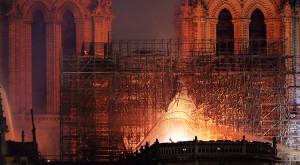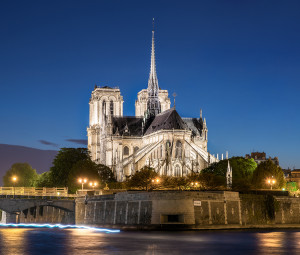 One recent morning the news had shocking pictures of the Notre Dame cathedral in Paris engulfed in flames. They showed a human chain of firefighters and people carefully removing the art treasures from the still-burning building. Here was a church that had survived revolutions and wars (even two world wars), yet now, while undergoing a peaceful restoration, it was burning. A world monument to man’s advancement in the medieval ages – creating a cathedral to God and advancing in art and science. My heart fell – this could not be happening, but it was. When the worst of the fire was over there was some hope. The rose-stained glass windows, that were created in the mid-1100s, were able to be salvaged. These windows were also called a wheel window which copied from antiquity the Roman oculus, meaning eye. The rose windows started with a stained-glass center and increased with groups of smaller windows that radiated out from the center. These windows were an important part of Gothic Architecture. What is Gothic Architecture? This defines European architecture from the 1100s to the 1600s, which included cavernous masonry buildings. Also, many of these types of buildings used the flying buttresses. Resembling spider legs, these flying buttresses extended from the walls of the building and created an effective way of supporting the structure and keeping the walls from falling under the weight. The flying buttresses were part of the beauty of Notre Dame. With grace and elegance, the buttresses added to the look of the cathedral by allowing it to be larger and taller. Victor Hugo wrote the classic “The
One recent morning the news had shocking pictures of the Notre Dame cathedral in Paris engulfed in flames. They showed a human chain of firefighters and people carefully removing the art treasures from the still-burning building. Here was a church that had survived revolutions and wars (even two world wars), yet now, while undergoing a peaceful restoration, it was burning. A world monument to man’s advancement in the medieval ages – creating a cathedral to God and advancing in art and science. My heart fell – this could not be happening, but it was. When the worst of the fire was over there was some hope. The rose-stained glass windows, that were created in the mid-1100s, were able to be salvaged. These windows were also called a wheel window which copied from antiquity the Roman oculus, meaning eye. The rose windows started with a stained-glass center and increased with groups of smaller windows that radiated out from the center. These windows were an important part of Gothic Architecture. What is Gothic Architecture? This defines European architecture from the 1100s to the 1600s, which included cavernous masonry buildings. Also, many of these types of buildings used the flying buttresses. Resembling spider legs, these flying buttresses extended from the walls of the building and created an effective way of supporting the structure and keeping the walls from falling under the weight. The flying buttresses were part of the beauty of Notre Dame. With grace and elegance, the buttresses added to the look of the cathedral by allowing it to be larger and taller. Victor Hugo wrote the classic “The  Hunchback of Notre Dame” about Quasimodo the bell-ringer who lived in the bell tower. Well, those very bells he wrote about survived. The largest bell, called Emmanuel, weighs 13 tons. It still rings and was added to the bell tower in 1685. The bronze statues of the 12 apostles had been removed from the church before the fire, but it is estimated that only 30% of the artwork and relics that were kept in the cathedral have been saved. The foundation stone of Notre Dame was laid in the year 1163 and the cathedral was completed in 1345. Since its conception, it has been part of the Paris skyline for 856 years. With 70% of the art and relics not saved, this is a sad and devastating loss of history, for sure. It is estimated that it will take at least 20 years to restore the cathedral, which is a short time in this landmark’s overall lifetime, but for a world that needs more beauty and more preserved history, far too long.
Hunchback of Notre Dame” about Quasimodo the bell-ringer who lived in the bell tower. Well, those very bells he wrote about survived. The largest bell, called Emmanuel, weighs 13 tons. It still rings and was added to the bell tower in 1685. The bronze statues of the 12 apostles had been removed from the church before the fire, but it is estimated that only 30% of the artwork and relics that were kept in the cathedral have been saved. The foundation stone of Notre Dame was laid in the year 1163 and the cathedral was completed in 1345. Since its conception, it has been part of the Paris skyline for 856 years. With 70% of the art and relics not saved, this is a sad and devastating loss of history, for sure. It is estimated that it will take at least 20 years to restore the cathedral, which is a short time in this landmark’s overall lifetime, but for a world that needs more beauty and more preserved history, far too long.
Previous ArticleCalendars, Convoys & Chrome
Next Article Tastefully Tough
SharLeigh
SharLeigh has an inquisitive nature – she is interested in current events, history, science and many more subjects, including things that go bump in the night! Since 1997, SharLeigh has scoured the internet, looking for interesting, fun and timely topics covering all sorts of human-interest subjects for her articles from her home in Fontana, CA.
